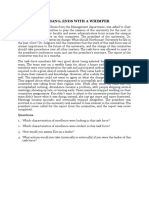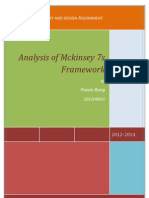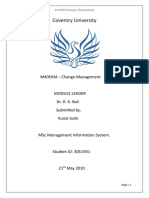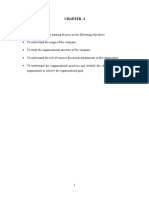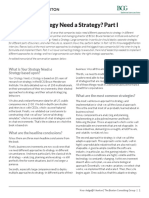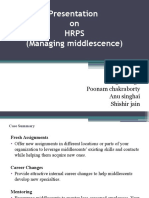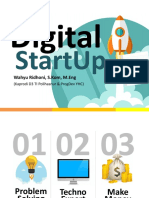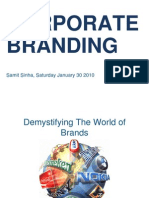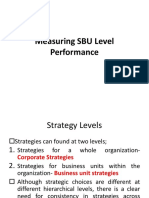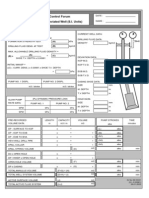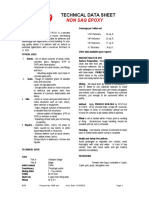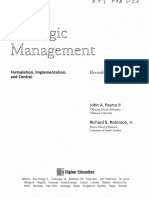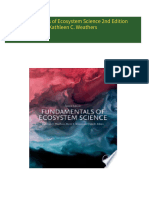Case Study
Case Study
Uploaded by
iakoiako93Copyright:
Available Formats
Case Study
Case Study
Uploaded by
iakoiako93Original Description:
Copyright
Available Formats
Share this document
Did you find this document useful?
Is this content inappropriate?
Copyright:
Available Formats
Case Study
Case Study
Uploaded by
iakoiako93Copyright:
Available Formats
Introduction TrueLocal.com.au is one of the fastest growing online business directoryservices website in Australia.
It operates as its own functioning business unitunder the umbrella of News Digital Media (NDM) organisation, a managinggroup for a cluster of individual digital companies that is owned by RupertMurdochs News Corporation, one of the worlds largest global mediacompanies. This case study examines the change that occurred in Truelocalwhen almost the entire senior management staff level was replaced includingthe CEO two years ago.Organisational change is something that occurs throughout an organisationslife cycle and effects the entire organisation rather than one part of it.Employing a new person is one example. Change is increasing due to anumber of forces including globalisation led by rapidly advancingtechnologies, cultural diversity, environmental resources and the economy;therefore the ability to recognise the need for change as well as implementchange strategies effectively, in a proactive response to internal and externalpressures is essential to organisational performance. Internal changes caninclude organisational structure, process and HR requirements and externalchanges involve government legislation, competitor movements and customer demand (Wood et al, 2010) Change does not need to be a painful process, as it may seem whenobserving the amount of failed change management initiatives with reports aslow as 10% of researched success rates (Oakland & Tanner, 2007), when 2 successful change management strategies are utilised and planned, includingeffective communication strategies, operational alignment, readiness tochange and implementation, which all lower and overcome resistance (Woodet al, 2010).There is a great amount of literature on the negative aspects and difficultmanagement with employees resisting change, however Wood et al (2010)challenge this notion by questioning the change management process aspeople do not resist change itself but aspects of the change that affects thempersonally such as fear of the unknown, status, remuneration and comfort.Resistance to these changes is a healthy reaction and can be managedeffectively in the beginning by ensuring communication and using one of thechange initiatives described here . 3
Background Information Truelocal is based in Sydney, with small sales branches in Brisbane andMelbourne. It employs over 150 staff, an increase of approximately 50% over the past two years. It was founded in 2005 by NDM as part of an expandingoperation of online websites to provide across the board consumer services,including news and magazine websites; online sport and weather information;and shopping comparison search engine, webbased recruitment, and travelsearch engine solutions [http://www.newsdigitalmedia.com.au, accessed25/08/2010]. As the world shifted into what is often referred to as the digital info age,consumer demand for online media as a way to source informationsignificantly increased and demand for printed media decreased puttingpressure on newspaper companies to expand to producing news andinformation online in digital format. This included News Corporation whichdecreased its newspaper operations and increased its digital expansion. As an employee at Truelocal for over six years, I have acquired thisinformation presented here through interviews with management, companyinformation and my own observations internally within the organisations salesdepartment working in the roles of sales executive, account manager andsenior retention account manager
The Need for Change Management & StructureTruelocal needed to align its culture, values and structure with the parentcompany in order to meet strategic growth goals not long after it was founded.Wood et al (2010) describe the work of an author, Noel Tichey on managingstrategic change. Experts use three fundamental sets of change in their approach; technical design, political allocation and culture/ideological mixproblems. It is one of these problems that becomes a pressing issue at anyone time of which then initiates the change. In Truelocals case there were anumber of changes evolving and at this time it was culture problems.NDM has been growing in size since its establishment in 2006 with a number of acquired website operations, each operating as a separate business unitwith the support of HR, Finance, IT, Commercial Operations and other support services provided by the parent company (NDM). A decision wasmade to align the organisation in terms of operations, culture and strategy soit could concentrate on innovation and performance to achieve its goal of becoming the number one provider of online information in Australia. As aresult NDM redesigned its organisational structure as Truelocal and most of the other business units
merged together in one location. Not long after thisrelocation, Truelocal began flattening out the company structure lead by anew management team and CEO. It has since been under constant changeto achieve its goal to continue growth (both in number of staff andperformance) and excel as a high performing and innovative company with anagenda of being the second largest online directory service in Australia after its competitor Sensis (Yellow pages online). Wood et al (2010) explain the 5
performance gap is a desire to move from one less desired state to another.This can be seen by the increased performance after the change occurredand culture change was implemented.What changedFundamental changes that occurred were a shift from the existing vertical,bureaucratic structure to a horizontal structure and change in specialistfunctioning of divisions creating a professional, corporate environmentalculture that was customer focused. The existing culture was a casual attitudetowards dress requirements, starting and finishing times, breaks, informalcommunication expression and channels and many staff were employed asfriends of existing staff rather than based on competency and job skills. Somemanagers had their partners working for them and a few were familymembers. There didnt appear to be any dress code and people came andleft work at varying times. Additionally management employed more skilled staff, retrained existing staff and created processes of which procedures were then put in place. One of the ways these objectives were achieved was by the reduction of management layers resulting in more direct reporting. Wood et al (2010)explain as organisational size increases, the more interconnections and lessdirect communication between people takes place (Wood et al, 2010) in terminations. According to The Economist (2008), in the economicdownturn companies need Generation Y as hungry 25-35 year olds withoutcommitment, for marketing and product innovation with emergingtechnologies, able to put in the time and energy to help them deal withrecession hazards, especially in sales.Strategy operations and planning were clarified at monthly and quarterlymeetings including product changes. These were addressed by departmentmanagers regularly and CEO meetings irregularly, to engage staff. Wood etal (2010) explain leadership has changed from the traditional trait andbehaviour approaches to transformational, charismatic, visionary focus and isseparate from management. The leadership team at Truelocal formallyincludes the CEO
and parent company (NDM) leaders. Their leadershipfunction can be observed by their language and behaviours they use atransformational and visionary change approach.Objectives specific performance targets were set allowing staff to earn ahigher commission by overachieving set targets, recognition and prizes toincrease motivation consistently.Purpose both the CEO and the parent company made organisational goalsclearly communicated vision and clarified progress regularly. Recognitionwas given for the contribution of each department and each business unit tothe overall success of the organisation.These changes were managed by senior staff using a combination of changestrategy approaches as explained by Wood et al (2010) that include a forced 10 approach of top down command, one way communication, coercive rewardand punishment approach, rationalisation approach and shared decisionmaking, empowered approach. Of these approaches no single approach wasconcluded best by researchers on organisational change and it is advised thatmore commonly a combination will occur, however guidelines are offered tochange agents and managers (Wood et al, 2010); consider use of expert consultants communicate the need for change feedback from employees avoid changing for the sake of change study organisational change and structuresFrom this perspective Truelocal management took the right approach byvarying the way they managed the change. Change Results The facilitation of clearer and faster communication channels enabled staff towork more efficiently and get things done faster, along with improvedtechnology. Further benefits of this structure were people collaborating inteams, using initiative and increased spontaneous communication while rules,procedures and close supervision were reduced as described in (Tushman, Anderson & OReilly, 1997).Wood et al (2010) describe the matrix structure is common in largeorganisations wanting to improve customer responsiveness. Truelocalsreporting structure utilised this organisational design as part of the change, for 11
example the finance manager reports to the CEO of Truelocal and to theCommercial Director of NDM, however Wood et al (2010) note eachorganisations structure is unique and there is no single observed design.This change is described by Wood et al (2010) as radical. Radical changesare fundamental reorientations and transformational, often initiated by thearrival of a new CEO. Culture & Performance Change Since the change occurred, Truelocals sales department recorded a growthrate of 15% per full time employee (FTE). Some strategies used were
Recognition employee of the month award was created byencouraging staff to use an online submission for their preferred co-worker who had gone over and above their job requirement displayingone of the company values. In addition the company awards the salesdepartment with the person with the highest dollar value in sales andyearly a larger reward of which one year was a new car. Similarly anewsletter recognises new sales people who achieve early in their job. All of these reinforcements are called extrinsic which are rewards given tosomeone by another persons valued outcome and because they areenvironmentally impactful are valued in influencing behaviour through the lawof effect (Wood et al, 2010).Cultural change can take years according to Wood et al (2010), however effective cultural change strategies can be used to shorten the timeframe.One of which is explained by Oakland & Tanner (2007), it is important to alignthe culture to support the desired change in behaviour. For exampleTruelocal needed a professional, customer focused culture which requiredstaff to develop professional skills and behaviour. The result was alldepartments undertook a full training programme designed to increaseawareness in communication, with a focus on questioning and empathy. 13 Conclusion Truelocal is a young company and part of the larger and still relatively newparent organisation, NDM, operating under the global News Corporation. Theindustry it operates in, digital media, is one of the fastest growing andchanging environments globally.It changed from a structure and culture of casual, unprofessional workpractices managed within a more bureaucratic structure that was under performing to a transformational, high performing, innovative and professionalculture
that is customer focused.Truelocal achieved its goal of growth, productivity and change in culture,however many staff were lost in the process and not much planning appearedto be in place. It is unclear as to the lack of planning, communication or useof external consultant in the case of radical change that occurred. Oneassumption might be due to budgetary restrictions as the company has beenrunning at a loss since it started, reporting a loss this year of over onehundred million. Apart from the successful change management strategies that were used bythe change agents, in particular the motivational strategies used by nominatedchange managers, numerous other approaches were identified that maybenefit the organisation for managing future changes more effectively. 14 Reference List Carless, S.A. (2005). Person-job fit versus person-organisation fit aspredictors of organisational attraction and job acceptance intentions: alongitudinal study. Journal of Occupational and Organisational Psychology. 78 (3), 411-429.Generation Y goes to work (2008, December 30). The Economist (US).Retrieved from http://www.economist.com/business/displaystory.cfm?story_id=1286357 3Oakland, J. S., & Tanner, S. (2007). Successful change management. Total Quality Management, 18 (1-2), 1-19.Tushman, M.L., Anderson, P.C. & OReilly, C. (1997). Technology cycles,innovation streams and ambidextrous organisations: organisaiton renewalthrough innovation streams and strategic change. Managing strategic innovation and change. Oxford University Press, NY. 2-23.Wood, J, Zeffane, R., Fromholtz M., Wiesner R., Creed A., Schermerhorn J.,Hunt J., & Osborn R., (2010). Organisational Behaviour, Core concepts &applications. 2 nd Ed. John Wiley & Sons, Australia, Ltd. Milton Qld. 15
You might also like
- Pestel Amazon Prime AirDocument11 pagesPestel Amazon Prime AirQuảng Nguyễn ĐìnhNo ratings yet
- General Electric Medical Systems, 2002Document10 pagesGeneral Electric Medical Systems, 2002Jyotsna GautamNo ratings yet
- Starts With A Bang, Ends With A Whimper: QuestionsDocument2 pagesStarts With A Bang, Ends With A Whimper: QuestionsChanira0% (1)
- Infrastructure And Operations Automation A Complete Guide - 2020 EditionFrom EverandInfrastructure And Operations Automation A Complete Guide - 2020 EditionNo ratings yet
- Single Customer View Strategy A Complete Guide - 2020 EditionFrom EverandSingle Customer View Strategy A Complete Guide - 2020 EditionNo ratings yet
- Case Change Management and Change ProcessDocument6 pagesCase Change Management and Change ProcessashishNo ratings yet
- Case Study Burke LetwinDocument8 pagesCase Study Burke LetwinRafia BaigNo ratings yet
- Analysis of 7s Framework - MergedDocument9 pagesAnalysis of 7s Framework - MergedPravin Bang100% (2)
- Leading Change at Simmons CollegeDocument14 pagesLeading Change at Simmons CollegeDana Hlaine HtetNo ratings yet
- Change Management Essay of Nike CompanyDocument6 pagesChange Management Essay of Nike Companymmarikar27No ratings yet
- Strategic Service VisionDocument3 pagesStrategic Service VisionAnju SavithriNo ratings yet
- Implementation of Uart On An FpgaDocument31 pagesImplementation of Uart On An FpgaNishanth KrishnappaNo ratings yet
- DTC P1777 Step Motor - Circuit DTC P1777 Step Motor - Circuit DescriptionDocument4 pagesDTC P1777 Step Motor - Circuit DTC P1777 Step Motor - Circuit DescriptionRaul Rodriguez JuarezNo ratings yet
- A Case Study On Change Management and ProcessDocument13 pagesA Case Study On Change Management and Processabid hussainNo ratings yet
- Ascension PLC Change Case StudyDocument3 pagesAscension PLC Change Case StudyJonathan Alagiah0% (1)
- Organizational Strategy Organizational Design, Competences and TechnologyDocument42 pagesOrganizational Strategy Organizational Design, Competences and TechnologyPrashant NarulaNo ratings yet
- Case Study 16 Change Management.Document2 pagesCase Study 16 Change Management.Wylmer Ann DionisioNo ratings yet
- Celsius Tech Case Study SummaryDocument15 pagesCelsius Tech Case Study SummaryPraveen KumarNo ratings yet
- Change Managment Case StudyDocument4 pagesChange Managment Case StudyspurgeongeorgeNo ratings yet
- Coventry University: M40EKM - Change ManagementDocument31 pagesCoventry University: M40EKM - Change ManagementKunal JoshiNo ratings yet
- IbmDocument59 pagesIbmDarren_Fung_8729No ratings yet
- Sealed Air Diversey Merger Acquisition Presentation Slides Deck PPT June 2011Document40 pagesSealed Air Diversey Merger Acquisition Presentation Slides Deck PPT June 2011Ala BasterNo ratings yet
- AmazonDocument7 pagesAmazontimmcharles95No ratings yet
- Trends in Leadership ThoughtDocument12 pagesTrends in Leadership ThoughtNafisa Afsana TaskiaNo ratings yet
- Analysis of Organizational Agility in Education System of IranDocument5 pagesAnalysis of Organizational Agility in Education System of IranTI Journals Publishing100% (1)
- Chapter - I ObjectivesDocument44 pagesChapter - I ObjectivesShobanaNo ratings yet
- PLM IntroDocument33 pagesPLM IntroGeetanjali100% (1)
- Critical Success and Failure Factors of Business Process ReengineeringDocument10 pagesCritical Success and Failure Factors of Business Process ReengineeringQwertyNo ratings yet
- Managing The MatrixDocument6 pagesManaging The Matrixomgan1042No ratings yet
- MC Kinsey 7s Framework in Corporate Planning and Policy: Bishwajit BaishyaDocument4 pagesMC Kinsey 7s Framework in Corporate Planning and Policy: Bishwajit BaishyaAung Zaw HtweNo ratings yet
- Nmims Mumbai Chaar KadamDocument13 pagesNmims Mumbai Chaar KadamsaurabhNo ratings yet
- Does Your Strategy Need Strategy Part1Document4 pagesDoes Your Strategy Need Strategy Part1Mah MohNo ratings yet
- What Is Corporate Governance?: Key TakeawaysDocument1 pageWhat Is Corporate Governance?: Key TakeawaysFatima TawasilNo ratings yet
- Rita Mcgrath: The End of Stability: Rethinking Strategy For An Uncertain AgeDocument7 pagesRita Mcgrath: The End of Stability: Rethinking Strategy For An Uncertain AgeWilliamWRNo ratings yet
- B2e PDFDocument10 pagesB2e PDFAnupam MathurNo ratings yet
- Case Study 1 - Change ManagementDocument5 pagesCase Study 1 - Change ManagementHimanshu TiwariNo ratings yet
- Successful Organizational Change FactorsDocument13 pagesSuccessful Organizational Change FactorsKenneth Whitfield100% (1)
- Business OrganizationsDocument24 pagesBusiness OrganizationsHemang LimbachiyaNo ratings yet
- Presentation On Hrps (Managing Middlescence) : By: Gagan Singh Poonam Chakraborty Anu Singhai Shishir JainDocument6 pagesPresentation On Hrps (Managing Middlescence) : By: Gagan Singh Poonam Chakraborty Anu Singhai Shishir JainshishiriperNo ratings yet
- Background Business Case Key Elements of Organizational Structures Types of Organizational StructuresDocument15 pagesBackground Business Case Key Elements of Organizational Structures Types of Organizational StructuresKaterina Borodacheva100% (1)
- Change Management ReportDocument19 pagesChange Management ReportalhumdulilahNo ratings yet
- Entrepreneurs and Managers Are The Sides of The Same CoinDocument23 pagesEntrepreneurs and Managers Are The Sides of The Same CoinAmy SmithNo ratings yet
- Yahoo Case Analysis Anja Rosengaard FogDocument8 pagesYahoo Case Analysis Anja Rosengaard Fogapi-251463862No ratings yet
- Investigating The Influence of Bureaucratic and Humanistic Work Environment On The Employees' Work EthicsDocument17 pagesInvestigating The Influence of Bureaucratic and Humanistic Work Environment On The Employees' Work EthicsDamianus Abun100% (1)
- Swot Analysis InfosysDocument8 pagesSwot Analysis InfosysS.S.Rules100% (2)
- Dear IoT Platform Vendors, Please Read ThisDocument8 pagesDear IoT Platform Vendors, Please Read Thischardy99No ratings yet
- Change Managment Case Study 2015Document4 pagesChange Managment Case Study 2015pasareaNo ratings yet
- Role of Knowledge Management in Telecom SectorDocument24 pagesRole of Knowledge Management in Telecom Sectorsakshi88100% (3)
- B014 The Resilient EnterpriseDocument10 pagesB014 The Resilient EnterpriseShubhangi TerapanthiNo ratings yet
- Digital StartUpDocument19 pagesDigital StartUpWahyu Ridhoni100% (1)
- Cisco Grand StrategyDocument12 pagesCisco Grand StrategyKumar Kishore KalitaNo ratings yet
- Prism of Mercedes & BMWDocument51 pagesPrism of Mercedes & BMWabhay keshriNo ratings yet
- Measuring SBU Level PerformanceDocument32 pagesMeasuring SBU Level PerformanceRevati ShindeNo ratings yet
- 2Document5 pages2zohreh hosseinzadehNo ratings yet
- Make Your Organization a Center of Innovation: Tools and Concepts to Solve Problems and Generate IdeasFrom EverandMake Your Organization a Center of Innovation: Tools and Concepts to Solve Problems and Generate IdeasNo ratings yet
- EXPLORING KEY FACTORS THAT INFLUENCE TALENT MANAGEMENTFrom EverandEXPLORING KEY FACTORS THAT INFLUENCE TALENT MANAGEMENTNo ratings yet
- Leadership Is Fluid: An Entrepreneur’s Guide to Overcoming Growing Pains + Accelerating GrowthFrom EverandLeadership Is Fluid: An Entrepreneur’s Guide to Overcoming Growing Pains + Accelerating GrowthNo ratings yet
- Birds Repair PDFDocument13 pagesBirds Repair PDFEl SleskoNo ratings yet
- 5 Waves AnswersDocument2 pages5 Waves AnswersNoor Ulain NabeelaNo ratings yet
- QFD: House of Quality: Rupam Singh PGP25/104 Operations Management Iim Kozhikode Selection Process DateDocument1 pageQFD: House of Quality: Rupam Singh PGP25/104 Operations Management Iim Kozhikode Selection Process DateChirayu VijaywargiyaNo ratings yet
- Aston MartinDocument16 pagesAston Martindisha_nift9532No ratings yet
- Surface BOP Stack Operations SI - Deviated Well Kill SheetDocument0 pagesSurface BOP Stack Operations SI - Deviated Well Kill Sheetjosesito_amoroso2005No ratings yet
- Saudi Arabian Oil Company: Calculation SheetDocument1 pageSaudi Arabian Oil Company: Calculation SheetJohn BuntalesNo ratings yet
- Annex 205919700005773Document1 pageAnnex 205919700005773Brisk VpnNo ratings yet
- Non Sag Epoxy PDFDocument1 pageNon Sag Epoxy PDFpolaris0% (1)
- Culvert Write UpDocument10 pagesCulvert Write Upprime consultingNo ratings yet
- Assignment 1 - PGCM 11Document17 pagesAssignment 1 - PGCM 11Nilesh SondigalaNo ratings yet
- Bernstein 01 Introducing PsychologyDocument16 pagesBernstein 01 Introducing PsychologyVikas SinghNo ratings yet
- Strategic Management Amir Raslan Abu BakarDocument72 pagesStrategic Management Amir Raslan Abu BakarSivasakti Marimuthu100% (1)
- GS 8 B Manual Rev 1 3Document12 pagesGS 8 B Manual Rev 1 3Kz ElectricNo ratings yet
- Ideal AutotransformerDocument10 pagesIdeal AutotransformerBT21EE017 Gulshan RajNo ratings yet
- Machine Learning Laboratory: ManualDocument52 pagesMachine Learning Laboratory: Manualnftmarketing666No ratings yet
- ABC Task Slide 1Document9 pagesABC Task Slide 1Palash KukwasNo ratings yet
- Formulation, Implementation, and Control: Eleventh EditionDocument6 pagesFormulation, Implementation, and Control: Eleventh EditionKiko HuitNo ratings yet
- Worksheet 5 - Marketing Environment Domino PDFDocument2 pagesWorksheet 5 - Marketing Environment Domino PDFAdrian DominoNo ratings yet
- SIMILARSDocument1 pageSIMILARSdamian pNo ratings yet
- Complete Download Fundamentals of Ecosystem Science 2nd Edition Kathleen C. Weathers PDF All ChaptersDocument57 pagesComplete Download Fundamentals of Ecosystem Science 2nd Edition Kathleen C. Weathers PDF All Chapterssaebische100% (2)
- XG Mode: User GuideDocument176 pagesXG Mode: User GuideDavid FongNo ratings yet
- Floor Care Heavy Clariant WaxesDocument56 pagesFloor Care Heavy Clariant WaxesMaria Eugenia Civeira100% (1)
- DSA AnswersDocument25 pagesDSA AnswersLeroy MoyoNo ratings yet
- Cobas c111Document38 pagesCobas c111Kiwon ShimNo ratings yet
- 249th ACS National Meeting & Exposition: DenverDocument301 pages249th ACS National Meeting & Exposition: DenverMichael_Lee_Roberts50% (2)
- Solid Carbide End MillDocument33 pagesSolid Carbide End MillLuis PerezNo ratings yet
- MAT 540 Week 9 DQ (1,2,3,4) ALL ANSWEREDDocument2 pagesMAT 540 Week 9 DQ (1,2,3,4) ALL ANSWEREDJoyo MulyadiNo ratings yet
- Assignment 2Document3 pagesAssignment 2hassan6936tNo ratings yet


